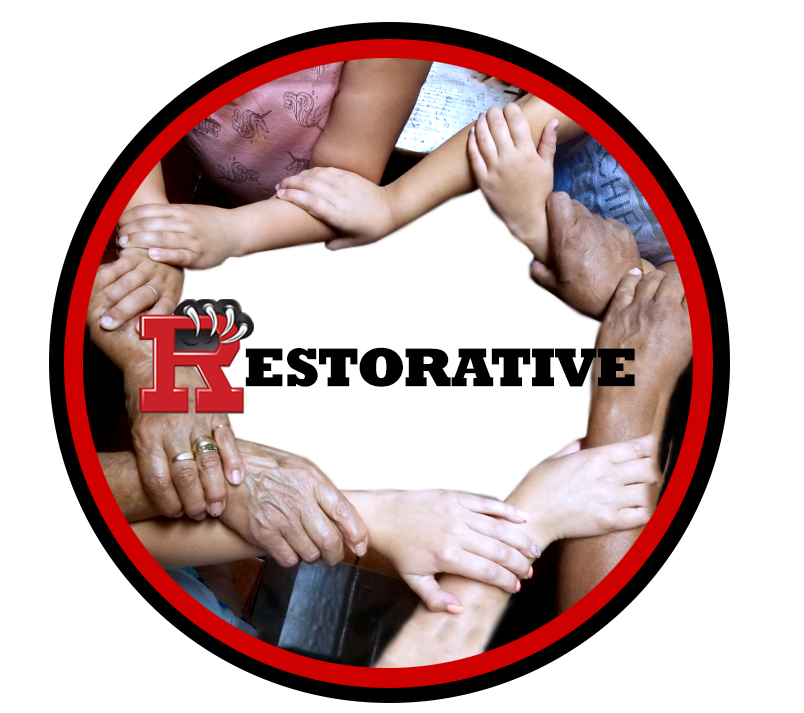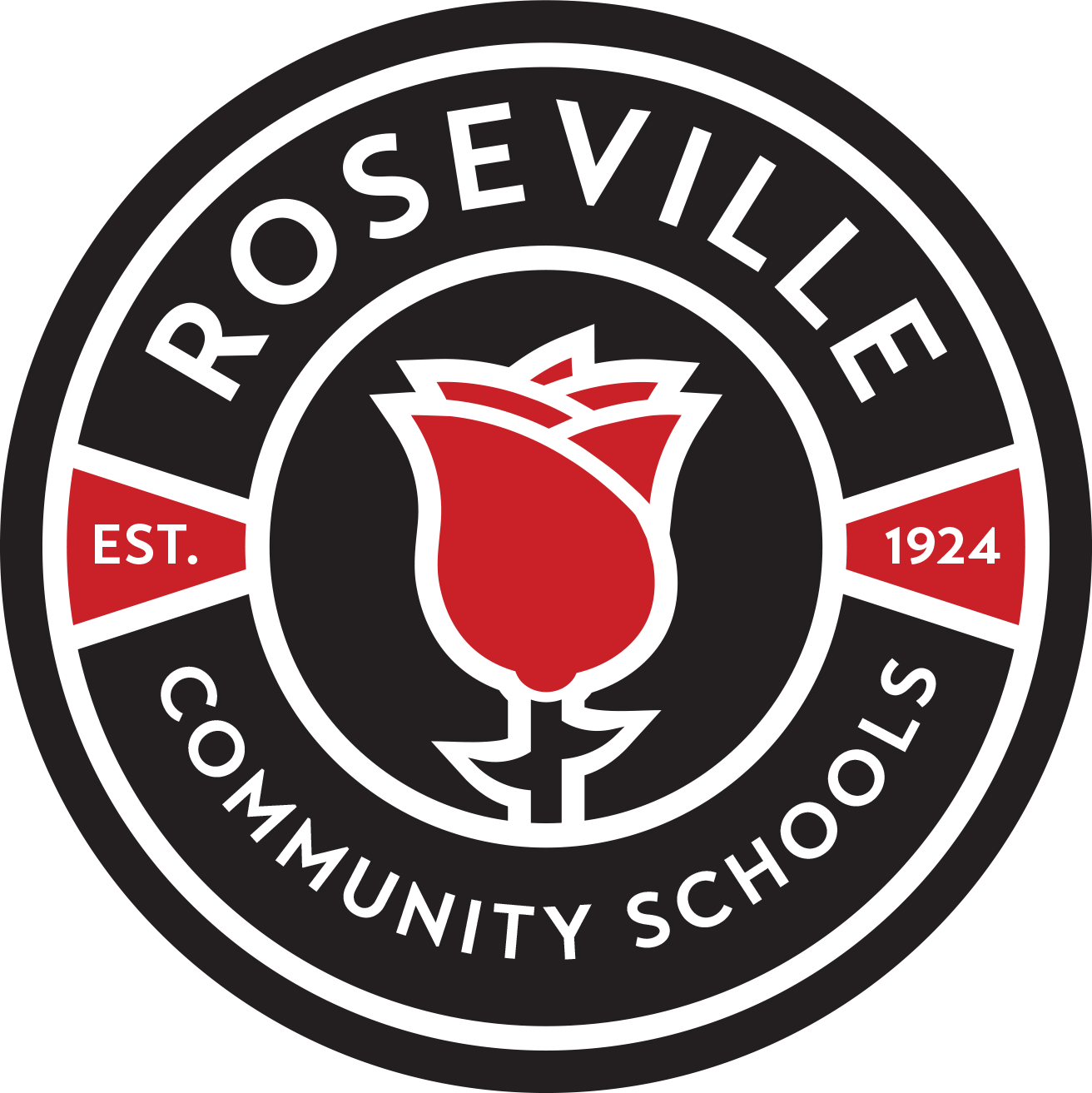RESTORATIVE PRACTICES IN OUR SCHOOLS

ROSEVILLE COMMUNITY SCHOOLS utilizes Restorative Practices in our buildings to create relationships, manage conflict, and repair harm whether the conflict is between students, a violation of the student handbook, or a conflict between staff and student. Our goal is to continually build respect and relationships which also creates a sense of empathy toward one another so we can socially coexist in order to provide the best learning environment.
Our “Restorative Lens” is a guiding thought process when dealing with choices that cause harm to the relationships in our school community. As Educators we offer a different way of thinking and responding to conflict and have done so for over 10 years at Roseville Community Schools. We use Restorative Justice in our classrooms and schools as we work together with our students and community to repair harm and to help minimize time out of school.
The use of Restorative Practice minimizes conflict, but should it occur, we use Restorative Justice, our response to harm, to manage and repair the conflict with those involved. Wherever there are human beings there is a chance of conflict; however, when people feel connected, they are less likely to harm on purpose… and if they do harm, they are more likely to repair quicker based on the bonds they have formed with one another. Roseville is committed to building a Restorative environment in our teachings and interactions to create a sense of community in our classrooms and schools, and should harm occur, an atmosphere where students want to belong to and work together to repair in order to be a part of our community here at Roseville Schools.
UNDERSTANDING RESTORATIVE PRACTICES AND RESTORATIVE JUSTICE
Restorative Practices is...
It is a pro-active approach with our daily interactions with others that creates and builds relationships and a community of respect.
- It is daily sincere conversations and interactions,
- Modeling and displaying respect within the classroom,
- Displaying respect with one another in our buildings and school community,
- Using affective statements and Restorative Questions to teach impact of our actions on others, and
- Defining and creating relationships to teach the obligations of those relationships within the community.
Restorative Justice is...
It is our response to harm that has been caused to relationships and the attempt to repair that harm and restore the relationships. To make it as right as possible.
Necessities for student mindset to participate in Restorative Justice when harm has been done to relationships:
- Offender must accept personal responsibility.
- ADMISSION on some level to choices is a requirement to participate.
- Be willing to reflect and understand how your choices affect others.
- Consider the victim’s needs.
- Be willing to repair the harm and the relationships.
WHY RESTORATIVE PRACTICES IN OUR SCHOOLS?
Students don't always make the right choices:
- In the classroom either with their own behaviors or academic effort,
- With their peers in the classroom or social settings,
- In how they treat and respond to staff members, and
- With continued and repeated unacceptable behaviors.
Our goal is to work with students to provide face-to-face opportunities to reflect on their choices and to explore how:
- To accept personal responsibility,
- To reflect on how they have affected others by their actions and consider the needs of others,
- To consider how to repair the harm with those they have affected and make it as right as possible, and
- To make a future plan to avoid repeating behaviors in an effort to not affect their learning time and the learning environment of others.
USES OF RESTORATIVE PRACTICES
Restorative Practices:
- Safely brings conflicted parties together to calmly manage and repair any harm emphasizing student participation and problem-solving skills to help provide a safer school environment.
- Encourages and teaches communication, understanding, tolerance, and empathy skills.
- Provides opportunities for students to reflect and examine choices while working in tandem with conventional discipline and the potential opportunity to reduce out of school suspension.
Restorative Justice is used for:
- Redirection of behaviors.
- Private or hallway conversations for disruptive choices.
- Community circles for social issues between students, students and staff, or entire classrooms.
- Circles for Suspension Reduction, Behaviors, and Academic Meetings.
- Family and Community participation in Restorative Conferences.
“ERASING” CONFLICTS - “WRITING” THE WRONG AND REPAIRING THE HARM
-
 Click to see a larger version
Skip to end of gallery
Skip to start of gallery
Click to see a larger version
Skip to end of gallery
Skip to start of gallery
-
 Click to see a larger version
Skip to end of gallery
Skip to start of gallery
Click to see a larger version
Skip to end of gallery
Skip to start of gallery
-
 Click to see a larger version
Skip to end of gallery
Skip to start of gallery
Click to see a larger version
Skip to end of gallery
Skip to start of gallery
-
 Click to see a larger version
Skip to end of gallery
Skip to start of gallery
Click to see a larger version
Skip to end of gallery
Skip to start of gallery
-
 Click to see a larger version
Skip to end of gallery
Skip to start of gallery
Click to see a larger version
Skip to end of gallery
Skip to start of gallery
-
 Click to see a larger version
Skip to end of gallery
Skip to start of gallery
Click to see a larger version
Skip to end of gallery
Skip to start of gallery
-
 Click to see a larger version
Skip to end of gallery
Skip to start of gallery
Click to see a larger version
Skip to end of gallery
Skip to start of gallery
-
 Click to see a larger version
Skip to end of gallery
Skip to start of gallery
Click to see a larger version
Skip to end of gallery
Skip to start of gallery
-
 Click to see a larger version
Skip to end of gallery
Skip to start of gallery
Click to see a larger version
Skip to end of gallery
Skip to start of gallery
-
 Click to see a larger version
Skip to end of gallery
Skip to start of gallery
Click to see a larger version
Skip to end of gallery
Skip to start of gallery
“SUPER-INTENDING” TO CONNECT WITH OTHERS - TAKING “NOTES” ON THE ABC’S OF COMMUNICATION
-
 Click to see a larger version
Skip to end of gallery
Skip to start of gallery
Click to see a larger version
Skip to end of gallery
Skip to start of gallery
-
 Click to see a larger version
Skip to end of gallery
Skip to start of gallery
Click to see a larger version
Skip to end of gallery
Skip to start of gallery
-
 Click to see a larger version
Skip to end of gallery
Skip to start of gallery
Click to see a larger version
Skip to end of gallery
Skip to start of gallery
-
 Click to see a larger version
Skip to end of gallery
Skip to start of gallery
Click to see a larger version
Skip to end of gallery
Skip to start of gallery
-
 Click to see a larger version
Skip to end of gallery
Skip to start of gallery
Click to see a larger version
Skip to end of gallery
Skip to start of gallery
-
 Click to see a larger version
Skip to end of gallery
Skip to start of gallery
Click to see a larger version
Skip to end of gallery
Skip to start of gallery
-
 Click to see a larger version
Skip to end of gallery
Skip to start of gallery
Click to see a larger version
Skip to end of gallery
Skip to start of gallery
-
 Click to see a larger version
Skip to end of gallery
Skip to start of gallery
Click to see a larger version
Skip to end of gallery
Skip to start of gallery
-
 Click to see a larger version
Skip to end of gallery
Skip to start of gallery
Click to see a larger version
Skip to end of gallery
Skip to start of gallery
-
 Click to see a larger version
Skip to end of gallery
Skip to start of gallery
Click to see a larger version
Skip to end of gallery
Skip to start of gallery
QUOTES TO KEEP US FROM GETTING “BORED” OF EDUCATION - INSPIRATION IS “ELEMENTARY” AND “SECONDARY” TO NONE
-
 Click to see a larger version
Skip to end of gallery
Skip to start of gallery
Click to see a larger version
Skip to end of gallery
Skip to start of gallery
-
 Click to see a larger version
Skip to end of gallery
Skip to start of gallery
Click to see a larger version
Skip to end of gallery
Skip to start of gallery
-
 Click to see a larger version
Skip to end of gallery
Skip to start of gallery
Click to see a larger version
Skip to end of gallery
Skip to start of gallery
-
 Click to see a larger version
Skip to end of gallery
Skip to start of gallery
Click to see a larger version
Skip to end of gallery
Skip to start of gallery
-
 Click to see a larger version
Skip to end of gallery
Skip to start of gallery
Click to see a larger version
Skip to end of gallery
Skip to start of gallery
-
 Click to see a larger version
Skip to end of gallery
Skip to start of gallery
Click to see a larger version
Skip to end of gallery
Skip to start of gallery
-
 Click to see a larger version
Skip to end of gallery
Skip to start of gallery
Click to see a larger version
Skip to end of gallery
Skip to start of gallery
-
 Click to see a larger version
Skip to end of gallery
Skip to start of gallery
Click to see a larger version
Skip to end of gallery
Skip to start of gallery
RESTORATIVE JUSTICE FACILITATORS:
Roseville High School
Karen Rice
(586) 445-5540
Roseville Middle School
Adrienne Miller
(586) 445-5600
Eastland Middle School
LaShonda Midgett
(586) 445-5700
